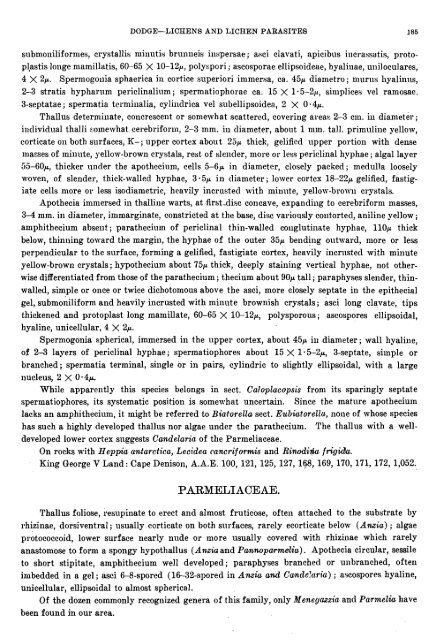You also want an ePaper? Increase the reach of your titles
YUMPU automatically turns print PDFs into web optimized ePapers that Google loves.
DODGE-LICEENS <strong>AND</strong> <strong>LICHEN</strong> <strong>PARASITES</strong> 185<br />
submoniliforn~es, crystallis minutis bruiliieis inspersae; asci clavati, apicibus i~lcrassatis, protopl-astis<br />
longe mamillatis, 60-65 X 10-12p, polyspori ; ascosporae ellipsoideae, hyaliiiae, uniloculares,<br />
4 X 2p. Spermogoliia sphaerica in cortice superiori immersa, ca. 45p diametro; nlurus hyalinns,<br />
2-3 stratis hypharum periclinalium; spermatiophorae ca. 15 X 1.5-2p, sin~plices vel ramosae.<br />
3-septatae ; spermatia terminalia, cylillclrica vel subellipsoidea, 2 X 0.4p.<br />
Thallus determinate, concrescei~t or somewhat scattered, covering area!: 2-3 cm. in diameter;<br />
inclividual thalli tomewhat cerebriform, 2-3 mm. in cliameter, about 1 mm. tall. primuline yellow,<br />
corticate on both surfaces, K-; upper cortex about 2Scr thick, gelified upper portion with dense<br />
inazses of minute, yellow-brown crystals, rest of dencler, more or less periclinal hyphae ; algal layer<br />
55-6OP, thiclrer under the apothecium, cells 5-6tr in diameter, closely packed; medulla loosely<br />
woven, of slender, thick-walled hyphae, 3.5p in diameter; lower cortex 18-22p gelified, fastigiate<br />
cells more or less isodiametric, heavily incro~tecl with minute, yello~v-bro~vii crystals.<br />
Apothecia immersed in thalliiie warts, at firstdisc concave, expanding to cerebriform masaws,<br />
34 mm. in diameter, immarginate, constricted at the base, disc variously contortecl, aniline yellow ;<br />
amphithecium absent ; parathecium of periclinal thin-walled collglutinate hyphae, llOp thick<br />
below, thinning to~vard the margin, the hyphae of the outer 35p bending outward, more or less<br />
perpendicular to the snrface, forming a gelified, fastigiate cortex, heavily incrustecl with minute<br />
yellow-brown crystals; hypothecium abont 75p thick, deeply staining vertical hyphae, not otherwise<br />
differentiated from those of the parathecium ; thecium about 90p tall ; paraphyses slender, thinwalled,<br />
simple or once or twice dichotomous above the asci, more closely septate in the epithecial<br />
gel, submoniliform and heavily incrusted with minute brownish crystals; asci long clavate, tips<br />
thickened and protoplast long mamillate, 60-65 X 10-12p, polysporous; ascospores ellipsoidal,<br />
hyaline, unicellular, 4 X 2p.<br />
Spermogonia spherical, immersed in the upper cortex, abont 45p in diameter; wall hyaline,<br />
of 2-3 layers of periclinal hyphae; spermatiophores about 15 X 1.5-2tr, 3-septate, simple or<br />
branched; spermatia terminal, single or in pairs, cylindric to slightly ellipsoidal, with a large<br />
nucleus, 2 X 0.4~.<br />
While apparently this species belongs in sect. Caloplacopsis from its sparingly septate<br />
spermatiophores, its systematic position is some~vhat uncertain. Since the mature apothecium<br />
lacks an amphithecium, it might be referred to Biatorella sect. Eubiatorella, none of whose species<br />
has such a highly developed thallns nor algae under the parathecium. The thallus with a welldeveloped<br />
lower cortex suggests Candelaria of the Parmeliaceae.<br />
On rocks with Heppia antarctica, Lecidea cancriformis and Rinodi&z frigda.<br />
King George V Land: Cape Denison, A.A.E. 100,121, 125,127, 168,169, 170,171, 172,1,052.<br />
PARMELIACEAE.<br />
Thallus foliose, resupinate to erect and almost fruticose, often attached to the substrate by<br />
rhizinae, dorsiventral; usually corticate on both surfaces, rarely ecorticate below (Aneiu) ; algae<br />
protococcoid, lower surface nearly nude or more usually covered with rhizinae which rarely<br />
anastomose to form a spongy hypothallus (Anziaand Pmnoparmelia). Apothecia circular, sessile<br />
to short stipitate, amphithecium well developed; paraphyses branched or unbranched, often<br />
inlbedded in a gel; asci 6-8-spored (16-32-spored in Anzk and Cande!(lria) ; ascospores hyaline,<br />
unicellular, ellipsoidal to almost spherical.<br />
Of the dozen commonly recogi~ized genera of this family, only Meneyazzia and Parntelia have<br />
been found in our area.

















